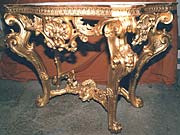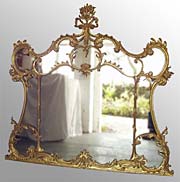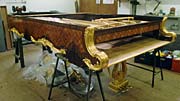  |
HOME | DESIGN | GILDING | GALLERY | LINKS | CONTACT |
GILDING
Covering objects with thin layers of gold leaf has been recorded in Egypt as early as 2500BC. In Northern Europe gilding with leaf on wooden sculptures was first recorded about 11th century. The techniques and processes have changed little since this time. Water gilding is a process in which gold leaf is applied to a carefully prepared surface with water, while in oil gilding the gold is applied to a varnished surface that has been allowed to dry to a barely perceptible tack. We are experienced in working with both processes on all types of projects from grand pianos, mirrors and frames, furniture antique and new, to architectural details, and gilding carved lettering. Gold in its pure form will not tarnish with age but will wear thin to reveal subtle colours from the underlying layers, giving old gilt surfaces their beautiful soft glow. Other metals (except platinum) do tarnish and are usually given a protective coating. The essence of traditional water gilding is in preparing the surface before the gold is applied. The Basic Process
The gold leaf is applied with water, the highlights burnished with agate burnishers. The new bright surface is then toned. Toning new gilding is a slow and skilful process and many interesting effects can be achieved. To preserve the art of beating gold leaf by hand, we obtain most of the leaf we use from See the whole process in detail in the Gallery. RestorationMuch of the gilding done in our workshop is the conservation and repair of damaged gilt surfaces. Old layers of paint, varnish and even subsequent layers of gesso are slowly stripped off to reveal the original gold underneath. Damaged or missing areas are repaired or re-carved, then gilded and toned to match the original gold. 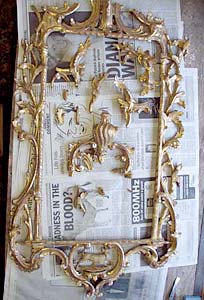 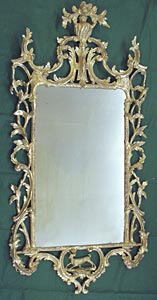
Mirror before restoration, The mirror after restoration, |
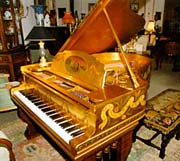 What is gilding? Gilding is the surface decoration of an object with gold leaf or other precious metals, such as silver or platinum.
What is gilding? Gilding is the surface decoration of an object with gold leaf or other precious metals, such as silver or platinum.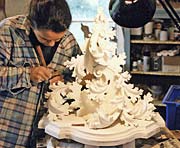
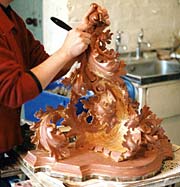 Layers of gesso, a mixture of rabbit skin glue and whiting are built up on the wood. When dry the gesso is sanded and the carved decoration is re-cut to sharpen the detail.
Layers of gesso, a mixture of rabbit skin glue and whiting are built up on the wood. When dry the gesso is sanded and the carved decoration is re-cut to sharpen the detail.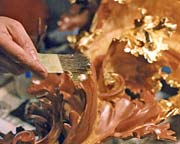
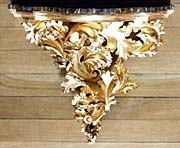 Layers of coloured clay (bole) are applied, starting with Ochre and finishing with a top colour depending on the age of the piece. This colour will determine the final effect of the gilt surface once the surface is toned.
Layers of coloured clay (bole) are applied, starting with Ochre and finishing with a top colour depending on the age of the piece. This colour will determine the final effect of the gilt surface once the surface is toned.